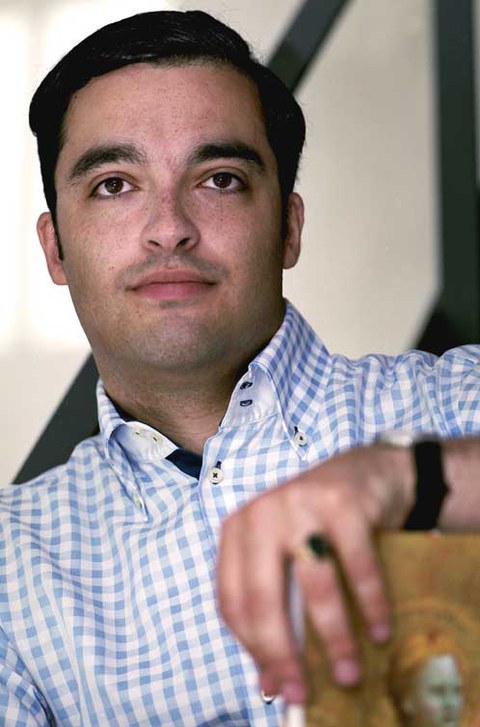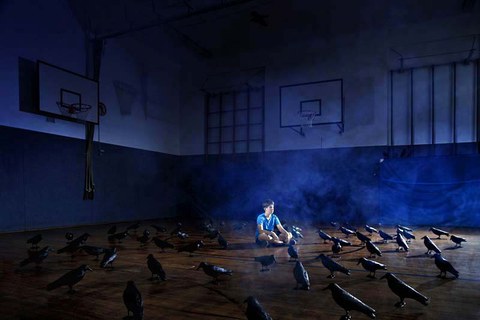From Master's degree to exhibition director
(Interview from 2013)
Tomas Petzold
Fresh out of university with a master's in art history and already on the staff of a high-profile art festival. Earlier this year, TUD graduate Moritz Stange became deputy artistic director of the international contemporary art exhibition Ostrale. The seventh Ostrale will run from July in Ostragehege, Dresden. This year's theme is "We cross the Rubicon".

Moritz Stange is the second artistic director of Ostrale.
Moritz Stange's academic route has been longer than some. He came to art history later in life with a wide range of experience – including in positions of responsibility. Now 32, he is a man who knows exactly what he wants: to advance an open discourse on art. Smart and confident, he is also calm, focused, and courteous.
He originally trained as a bookseller and had a leading role in setting up a specialist bookshop for graphics and art. "But then I realized that I was actually much more interested in the content of the books than in selling them," admits Stange. So, he caught up on his school-leaving certificate at the Freiberg-Kolleg adult education center and went on to study art history, history... and Catholic theology at Freie Universität Berlin. He thought having just the two subjects would be "too narrow" and he believes that doctrine holds the key to understanding ancient art as well as the cultural conditioning that continues to have an impact today.
The move to Dresden came about primarily for personal family reasons. Moritz Stange has no regrets, not least because he benefited from links between TUD and the Staatliche Kunstsammlungen Dresden (In English: Dresden State Art Collections). For example, there was the porcelain seminar with Prof. Ulrich Pietsch in the Kunstbibliothek (In English:art library), where the entire class could view the exhibits across the street after class; and the seminar with Prof. Ulrich Bischof in the Albertinum art gallery. Stange found the cultural scene in what is – compared to Berlin – a small city both less overwhelming and more open, full of opportunities to engage in discussion and conversation. The same applies to the "relatively small Faculty of Arts, Humanities and Social Science," which he found offered an excellent range of very good courses and above all, to the Freundeskreis des Kupferstich-Kabinetts (In English: Association of Friends of the Kupferstich-Kabinett), where he was previously an executive assistant and now sits on the board. He also established valuable contacts as a student assistant in the library of the Dresden Academy of Fine Arts.
However, instead of continuing his studies towards a doctorate with the help of a scholarship, he accepted an exciting offer from the association behind Ostrale to join Andrea Hilger as artistic director and curator of the exhibition. Stange's part-time work at the Dresden gallery M2A, where he was involved in selecting (young) artists and had given a number of impressive speeches at openings, had recommended him for the role. As a student, on the other hand, Stange engaged with bygone centuries: He was involved in a project on Matthias Oesterreich (1726-1778) and Oesterreich's Dresden caricatures, worked with Prof. Werner Busch on Adolph Menzel (1815-1905), and wrote his Master's dissertation on Sascha Schneider (1870-1927). While he was only gradually working his way up to the present in his studies, his private focus even during his time in Berlin was already on networking and contemporary art; on contact with gallery owners and collectors.

Part of "Grau 3" by Stephan Ortmanns, one of the exhibits in Ostrale 2013
"Professionalism and credibility should be the focus for Ostrale in the future – from the choice of artists to presentation to the public, on whose support in both conceptual and material terms we depend. The era of the appealingly new emerging from the underground is definitively over; for the time being, the focus is on the core business, namely the summer exhibition," says Moritz Stange.
He also sees collaboration with commercial galleries as a "tightrope act" and is clear about one thing: "We don't want to commit ourselves to the mainstream; we are not renouncing young, uncomfortable, non-commercial art." That being said, expensive works are also to be shown and major names showcased. On this point, too, contacts, ideas, and foresight are also needed, and so, weeks before the opening of the current Ostrale, Stange is already busy with edition 014, which will specifically focus on neighboring countries to the east.
"It's the 7th year now, which some people think is a cursed number," Stange says, "but I'm confident, because seven is actually a beautiful, balanced number according to Aristotle – a combination of three, which stands for the divine, and four, which stands for the natural. That is a combination that suits me very well..."
Curious about what is coming up in the 7th Ostrale?
Moritz Stange is giving TUD alumni an exclusive look at the art exhibition (free of charge) in a new series of events, "Absol(E)vent – der besondere Wochenausklang."
For more details, see Absol(E)vent – der besondere Wochenausklang für TUD-Alumni.
Contact details:
OSTRALE
Künstlerischer Leiter Moritz Stange
Messering 20, Frigolanda Kühlhaus
01067 Dresden
Tel.: +49 (0) 351-653 37 63
Email: Moritz Stange
Web: Ostrale
